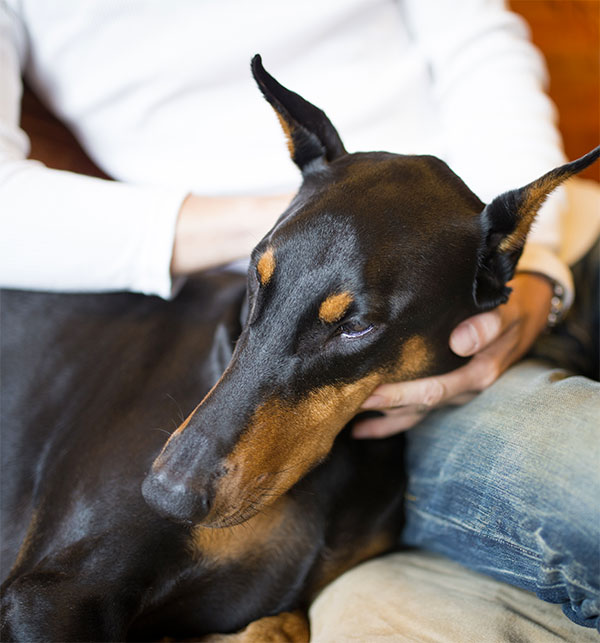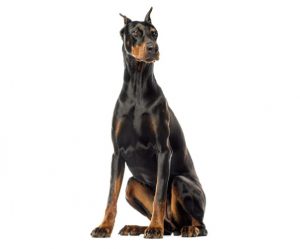
We Tried 5 Fresh Dog Food Brands
Is all the marketing hype worth it? Did our dogs enjoy them? Here’s our dogs’ totally honest review.
The Doberman has always been considered to be fearsome and aggressive. The movie industry almost always portrays it as a watchdog and rarely as a pet and this has established fear. One must separate fact from fiction and consider this magnificent family animal that is capable of defending its owners and displaying affection. It is very loyal and has an adequate behaviour.
Endowed with great strength of character, the Doberman requires proper training. As is the case for the majority of dogs, the owner must be firm and coherent and must provide the dog with proper socialization.
It is important to establish respect and to demonstrate who the master is. The owner that respects and is respected by its Doberman will inherit a loyal and happy dog.
Widely used as an attack dog, the Doberman is very courageous, fast and active. It is an active and athletic dog with amazing endurance to run long distances. It hates solitude and needs company to be balanced and happy. A Doberman that is left on its own in the backyard tied to a leach may become a dreadful weapon.
Despite its fearsome appearance, this dog is very affectionate and family friendly. Particularly attached to its home and family, it will protect its owners against anything. It is an excellent dog with children and will be loyal and devoted if it feels appreciated by the family members.


The Doberman is muscular and gives the impression that it is always on watch and ready to pounce. This medium-sized dog is powerful and elegant.
Between 68 and 72 cm (26.77 to 28.35 inches) for the male
Between 63 and 68 cm (24.80 to 26.77 inches) for the female
Between 40 and 45 kg (88.18 to 99.21 pounds) for the male
Between 35 and 38 kg (77.16 to 83.77 pounds) for the female
The coat may be of different colors. The breed standard accepts blue, fawn, red and black.
Hair is tight, smooth and short. It has no undercoat.
Its head has a slightly elongated shape. Its eyes are dark. Its triangular ears are often cropped for functional or aesthetic reasons. Otherwise, the ears naturally hang. The nose is black. Its tail is usually docked.
According to the FCI breeds nomenclature, this breed belongs to group 3, section 1 and is #143
Does this dog suit your lifestyle?
Every dog breed has its own characteristics. However, the actual character of a dog can vary from one to another within the same breed.
Find out if the Doberman is your ideal dog breed with our quiz.
That will take you less than 3 minutes!
Take the quiz







These very sharp and active dogs require to live in a household where physical activity will be part of their daily lives. A Doberman that properly spends its energy will be a happy and loyal dog.
Proper training must be given at a young age and owners need to be patient and constant. Because this dog is so powerful, the owner must be in control at all times.
The Doberman adores its family and will always be ready to protect it. Therefore, it is essential to give it proper training so that it may be alert while at the same recognizes who is the master.
It is important to ensure the dog does not become dominant in order to avoid potential problems.
The Doberman does not have particular health problems. It is a robust dog that is generally healthy. The Doberman may be affected with cataracts and dysplasia. Obviously, its coat does not allow it to withstand extreme cold weather. Also, this dog is vulnerable under hot weather because it is very active and does not know when to stop being active. In such cases, it is important to ensure that the dog is properly hydrated.
GROOMING
Because of its short and smooth coat, the Doberman does not require particular grooming care. A regular brushing will do the job. However, it is critical to protect this dog from extreme cold and extreme hot weather.
Its ears, if not cropped, should be checked regularly to prevent infection. If the ears are floppy, they should be cleaned regularly.
Emerging at the end of the 1860s, the Doberman is apparently the result of a cross between the Rottweiler and the German Pinscher. This explains the origin of the nickname "Doberman Pinscher. The Doberman Breed Standard also mentions the butcher’s dogs as an ancestor of the Doberman.
It is around the year 1870 that Frédéric Louis Dobermann, a tax collector, chose a combative and courageous watchdog to accompany him on his travels. He often carried significant sums of money for work and wanted adequate protection during his outings.
Since he managed the local dog pound at the time, he chose a dog to act as protection and the Doberman breed was thus created. The first animals were stocky, much smaller, had a short neck and a massive head.
In 1900, the first breed standard was created. Before then, a few improvements were made to the first Doberman but its elegance was developed thanks to a breeder by the name of Goller who admitted the Doberman to the "Cercle allemand du chenil".
In Germany, the breed quickly became very popular. The Doberman was used in both World Wars. The dogs were acclimated to explosions, trained to crawl, and taught not to bark. Certain dogs were capable of remaining mute even when injured.
It was first appreciated in Germany, then in neighbouring European countries and then worldwide. Around the year 1908, Americans continued to improve the breed and gave it even more elegance. In 1912, the Doberman became an official breed in Canada.

Is all the marketing hype worth it? Did our dogs enjoy them? Here’s our dogs’ totally honest review.